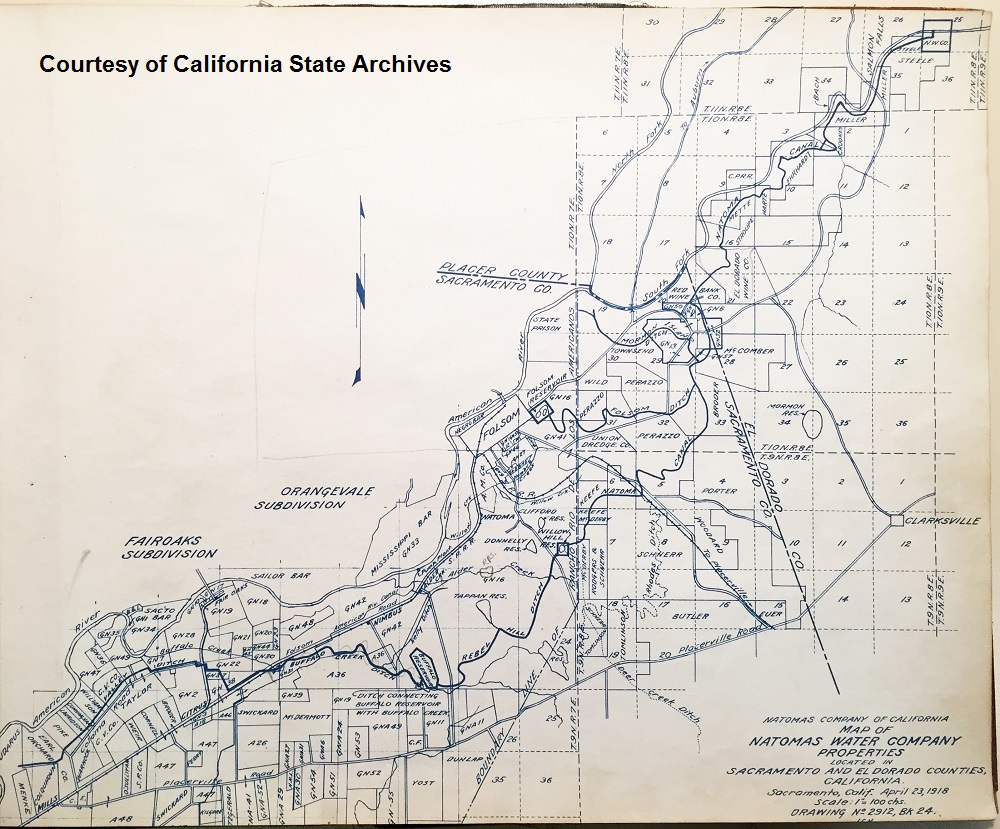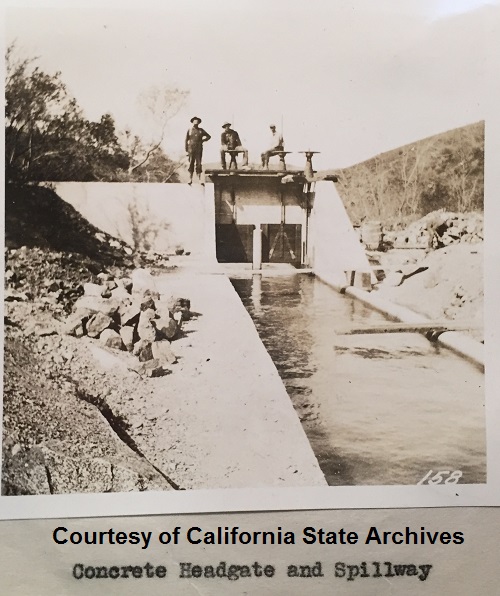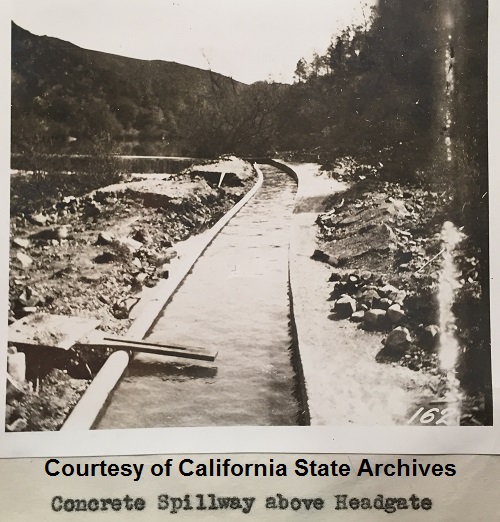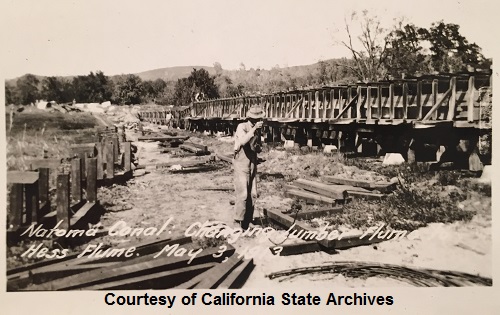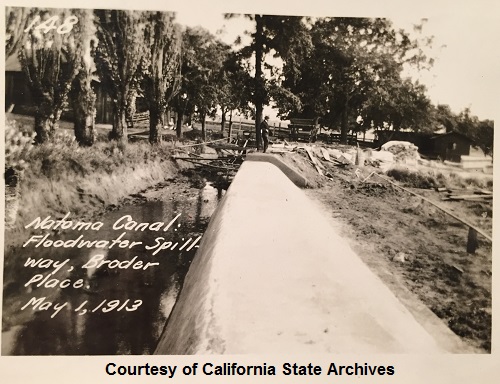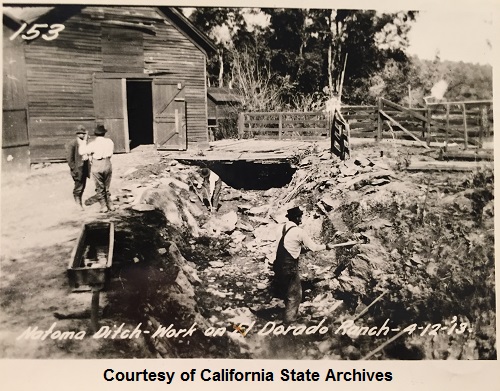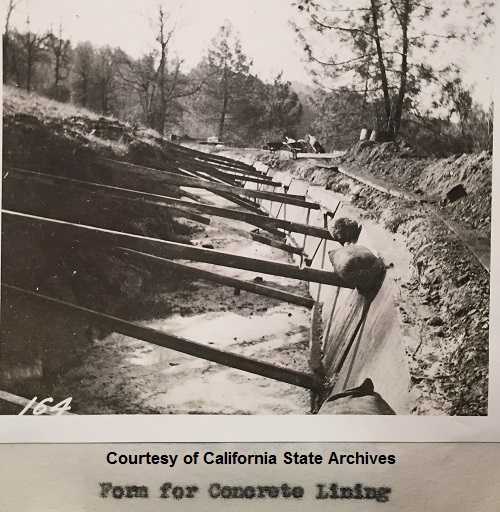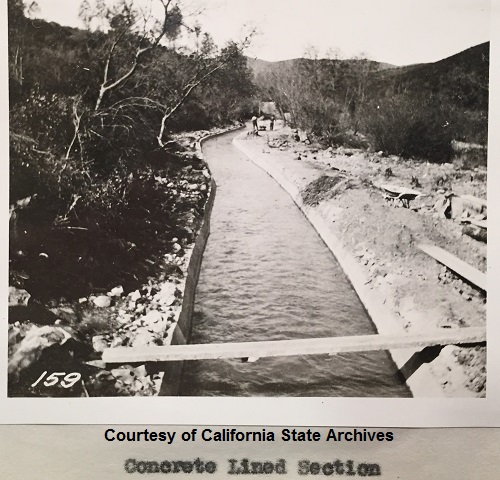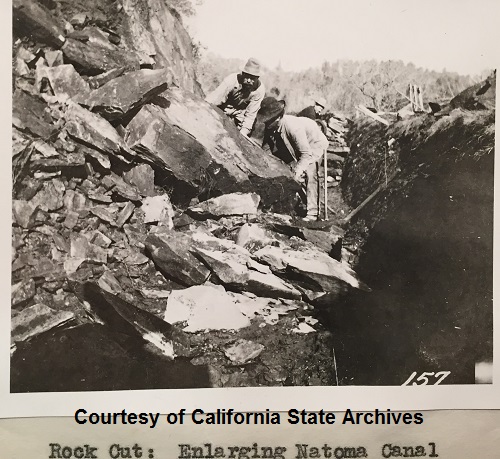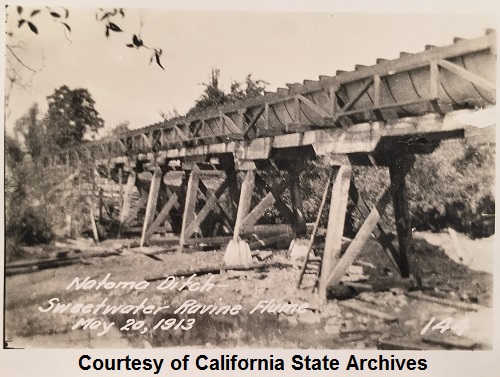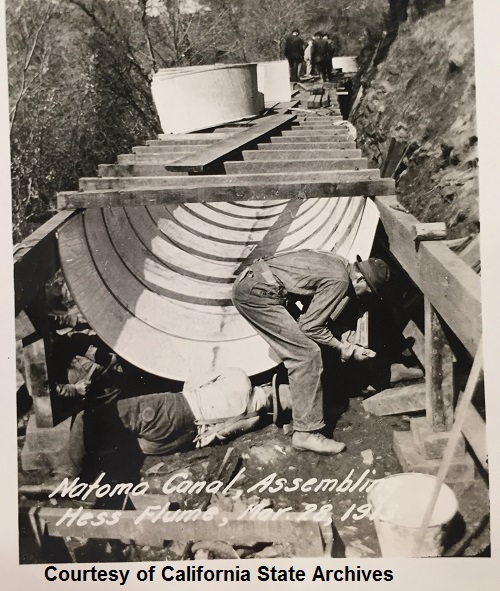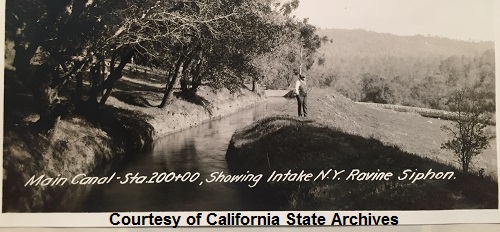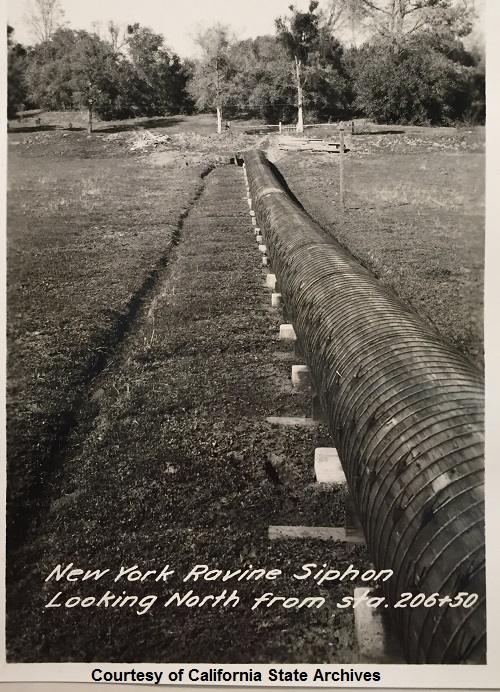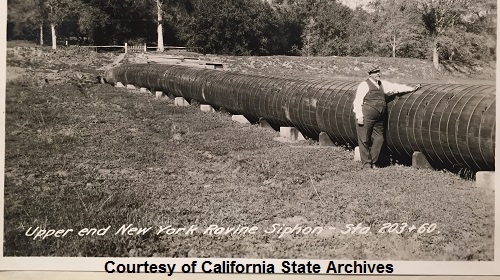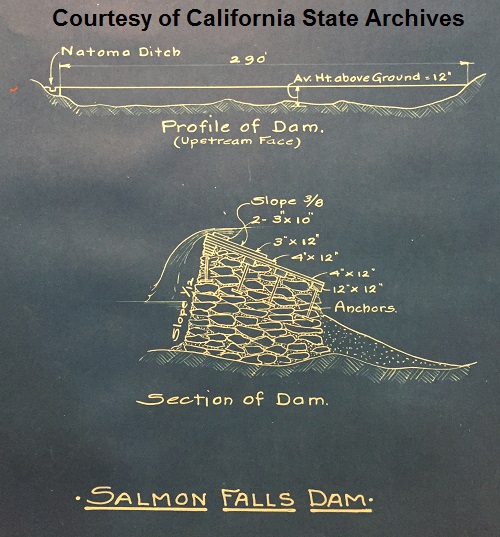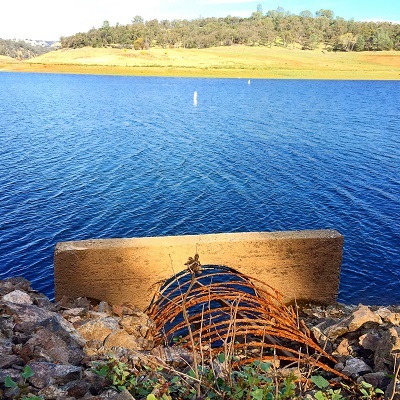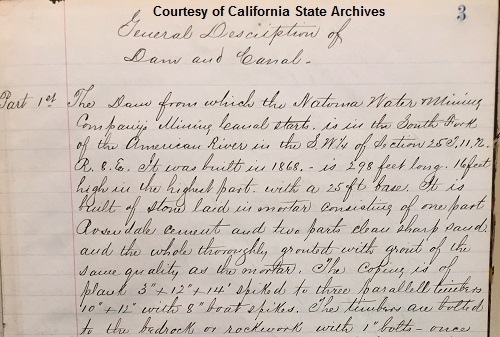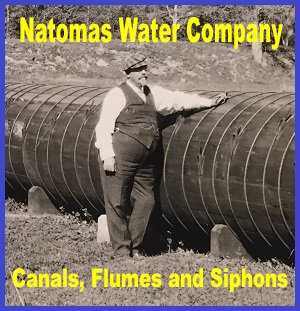
The canals, flumes, and siphons of the Natomas Water Company in the 1910s.
In 1921 the Natomas Water Company that operated the Natomas Ditch serving the City of Folsom and a variety small farms along the American River applied for higher water rates with the California Railroad Commission. Within the rate submission was a detailed outline of the Natomas water canal along with photos of the Natomas Dam on the South Fork of the American River, the New York Ravine wooden siphon, and other pictures detailing the canals and flumes. The detailed history of the Natomas canal ownership along with a complete inventory of the structures submitted with the application for higher water rates gives a glimpse of this important gold rush era water works project.
Natomas Water Company 1921 Rate Filing
In 1911 the California Railroad Commission was created to regulate public utilities such as railroads, electricity, telephone and water companies. The Railroad Commission was renamed the California Public Utilities Commission in 1946. The Natomas Water Company fell under the authority of the Railroad Commission when it came to its’ rate structure for water customers. In July of 1921, the Natomas Water Company filed a request for increased water rates with the Railroad Commission.
The basis for the increase in water rates was that current rates had not been raised in years and was not providing an adequate return relative to the value of the Natomas Water Company infrastructure. Of course, before any rates could be evaluated, a detailed capital investment report had to be undertaken to place a dollar value on the Natomas canal and associated structures for treating and delivering water in El Dorado and Sacramento counties.
Canals, Flumes, And Siphon Pictures
A detailed report on the Natomas Water Company canals and structures was produced by civil and hydraulic engineer George S. Nickerson. The report was titled Reproduction Cost, Physical Properties of the Natomas Water Company 1919. Along with map of the of water distribution system from the dam above Salmon Falls to farms at Mills Station in Sacramento County, the adjacent property owners were listed. Nickerson included every structure along the main water canal and branch canals indicating the distance from the dam, reservoir, or branch. Also included were detailed blue print as-built designs of the various flumes, gates, and siphons operation along the main canal.
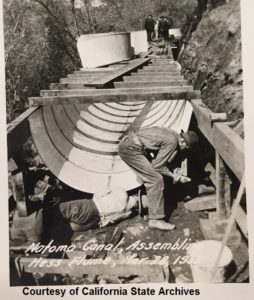
Workers install a Hess Flume, metal half pipe supported by wood, in 1913.
Perhaps most interesting to amateur historians such as me are numerous pictures of the different structures along the main canal and branches. In was during the 1910s that both the Natomas canal and the North Fork Ditch, the water canal on the North Fork of the American River, were undergoing significant improvements to reduce water losses. Chiefly, the canals were being lined with concrete. New metal flumes were replacing old wooden flumes and more diversion structures were being constructed of concrete. Nickerson includes photos of the Natomas canal before it was lined with concrete, men building new metal flumes, and great pictures of the redwood stave siphon that traversed New York Ravine.
All of Nickerson’s work was to establish the value of the Natomas Water Company capital investment in their structures. At the time of the rate application, the Natomas Water Company operated the following water conveyance structures and reservoirs.
- Natomas or Salmon Falls Dam 2 miles upstream from the community of Salmon Falls on the South Fork of the American River
- Natomas Ditch or main canal down to the Willow Hills Reservoir that was 93,650 in length.
- Mormon Island branch or lateral ditch was 9.500 feet
- Folsom lateral ditch was 27,265 feet in length and terminated in reservoirs above the City of Folsom.
- Rebel Hill Ditch started at the Willow Hill Reservoir to the Buffalo Reservoir. The Rebel Hill Ditch was approximately two miles long.
- Water was released into Buffalo Creek and then into the Alder Hill Ditch and then conveyed to the Valley Ditch.
- Valley Ditch slightly under 6 miles in length and conveyed water down to Mills Station
However, a map included Nickerson’s report shows the Alder Creek Ditch starting at the Willow Hill Reservoir and transferring water to the River Canal that eventually supplied the Valley Ditch. There were also other lateral ditches indicated on the map that went to gold dredging operations owned the parent company of Natomas Company of California.
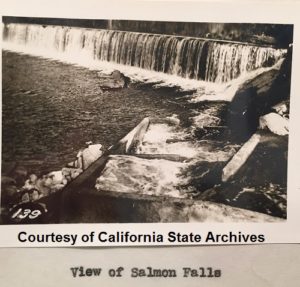
View of the Natomas Dam on the South Fork of the American River above Salmon Falls with fish ladder.
The Natomas Water Company readily admitted that it was virtually impossible to accurately estimate the value of the water system because at its inception in 1851, the ditch was constructed across unoccupied and unsurveyed public lands of the United States. Based on Nickerson’s report, improvements made between 1913 and 1919, current revenue, expenses, and debt, the Natomas Water Company valued their structures and property at $526,925. It’s interesting to note that the delivery of all the water was by means of gravity. No pumps were used to move the water from a canal to a reservoir or other lateral canal.
A separate appraisal undertaken by the Railroad Commission indicated an appraised value of $300,451 for the Natomas Water Company. The Railroad Commission also conducted hearings in San Francisco and Sacramento to hear from Natomas Water Company customers and expert witnesses. In the Railroad Commission’s Decision 11465 regarding the rate structure, they took issue with several of Natomas Water Company’s portrayal of their structures and operations.
The Commission is asked to determine the service value of this property to the water system and to include the amount so determined in the rate base for the purpose of this proceeding. This ditch is being used at the present by the applicant to deliver irrigation water to the American River Canal of the Natomas Mutual Water Company and then to the Valley Lateral. Testimony was submitted to the effect that the Natomas Consolidated of California constructed the Alder Creek dam several year ago, at a cost of approximately $21,000, for the purpose of impounding the muddy water, or tailings, from the gold dredges; also that the Alder Creek ditch was enlarged and lined with concrete in 1921 by the Natomas Company of California at a cost of $7,810.
It appears, from the evidence that as far as the practical value goes, the advantage afforded the Alder Creek dam are so slight that the Commission would be unwarranted at this time in considering it as a necessary and vital adjunct to the water system. It further appears that the Natomas Company of California, in dredging out a considerable portion of Buffalo Creek Channel, destroyed applicant’s sole means of delivering water to the Valley Lateral through its own ditch system, making it now necessary to use the Alder Creek Ditch and the American River Canal and the Natomas Mutual Water Company, in order to serve its patrons on the lower end of the system. – RR Commission Decision 11465
The Commission denied the Natomas Water Company’s conclusion that customers on the Valley Lateral should pay for restoring the Buffalo Creek conveyance as part of their water delivery system. They determined that the Natomas Company of California was responsible for rehabilitating the creek.
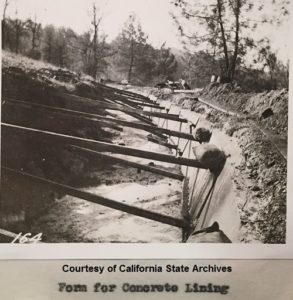
Wooden supports press sheets of plywood against the concrete lining of the Natomas Canal as the concrete cures.
The Railroad Commission also acknowledged in their 1922 decision that the Natomas Water Company had engaged in practices of limiting water sales at the lower rates. They did this by denying service to new customers or refusing to furnish more water for additional acreage to current customers. The basis for denying water service centered on the fact that there was only so much water that could be delivered. But the Commission threw out the water company’s argument that they just couldn’t meet demand because they really didn’t know how much water they were supplying to each customer.
Irrigation service being on a flat rate basis, there are no accurate water measurements available to determine the actual use of water. Measurements of water used for dredge mining are equally unreliable. No doubt there has been wasteful and unnecessary use of water of this system, as is usual when flat rates are charged. The demand for water in the territory served by the applicant has increased to such an extent that conservation of the supply is urgently needed. This can be accomplished to the best advantage of all concerned by the adoption of a measured rate for all irrigation, mining, and similar service. The sale of irrigation water on a measured basis will practically eliminate carelessness and waste in the distribution and use. – RR Commission Decision 11465

Workers begin the process of preparing the Natoma Ditch for concrete lining at the El Dorado Ranch in 1913.
The Commission decided some flat rates could continue for a limited time, but all service had to eventually be metered in some fashion. Monthly metered rates for domestic use set at $1.00 for the first 500 cubic feet. The next 1400 cubic feet would be $.10 per 100, and usage over 2000 cubic feet would be $.08 per 100. The minimum monthly charge for a 5/8” meter would be $1.00. The largest 3 inch meters would be charged $4.00 per month. For irrigation and mining, the water rates were to be $.08 for each miner’s inch of flow for 24 hours. (Fifty miner’s inches shall be taken as the equivalent of 1 cubic foot of water per second).
However, the Railroad Commission was not done setting a new foundation for the delivery and cost of water to residents. They also tackled the entitlement some landowners and farmers felt when it came to the water they were receiving. Specifically, the delivery of water through a ditch system did not convey a right to that water. Contracts for water do not live in perpetuity.
Considerable controversy developed during the hearing in the matter involving the status of certain contracts under which the majority of the water users located on the Valley Lateral have been receiving water since 1893 and 1894. It appears that there are ten irrigation consumers who hold contracts made with the Natoma Vineyard Company (one of the predecessors of the Natomas Water Company) providing, among other things, that water shall be furnished in such quantities as the irrigationists desire at any and all seasons of the year for a fixed sum of $5.00 per acre per year for the bearing orchards, vineyards, and other crops, and $3.00 per acre per year for non-bearing orchards and vineyards. These consumers claim that their contracts are still in force and that as to them the company is not a public utility and the rates fixed by their contracts cannot be changed.
This contention cannot be upheld. The evidence is clear that the canal system and the water originally appropriated has been from the beginning impressed with public use. When the Natoma Vineyard Company acquired the system from the Natoma Water and Mining Company on November 11, 1893, it acquired a public utility system. It could not change the character of that system. Nor could it, by contracts made either before or after it acquired the system, carve private rights out of the public use to which the system had been devoted. – RR Commission Decision 11465
The Commission decided, irrespective of any previous contracts signed between landowner and the Natoma Vineyard Company that all water customers would have to abide by the new rates. The Commission shot down another prevalent practice of the Natomas Water Company that forced consumers on the Mormon Island Lateral to clean and maintain the branch ditch in order to continue receiving water.
Aside from water companies forcing their consumers to clean and maintain the water service lines to their properties, many of the same issues and perceptions are being fought today as were brought up in 1922. Water districts say they need to raise rates to maintain and operate the distribution system. Consumers in many of those districts feel they are being gouged by high water prices. Some of the practices, decisions, and employee compensation of the water district may not be in-line with the average wages of the residents they serve. Some water consumers feel they have an irrevocable right to water, to use any way they see fit, and pay the same price as they did thirty years before. Some things never change.
Map and Pictures of the Natomas Water Company from 1913 – 1918
Click image to enlarge
References
Public Utilities Commission App No 6975 Application of Natomas Water, January 3, 1923. F3725:7098-7101a, comprising of
- Natomas Water Company Application 6975
- Railroad Commission Decision No. 11465
- Reproduction Cost Physical Properties of the Natomas Water Company, 1919, by George S. Nickerson, Hydraulic Engineer
- 1880 Journal of the Natomas Water and Mining Company General Description of Dam and Canal.


